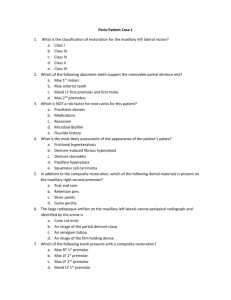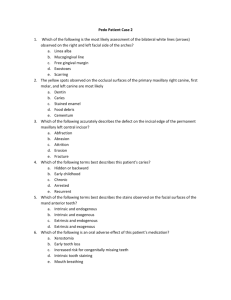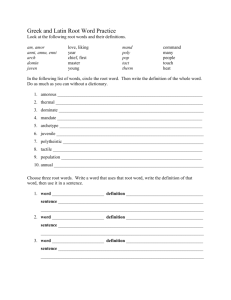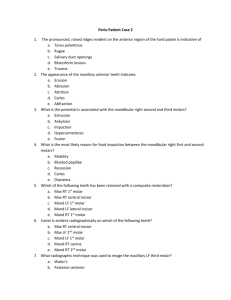Dental Anatomy
advertisement
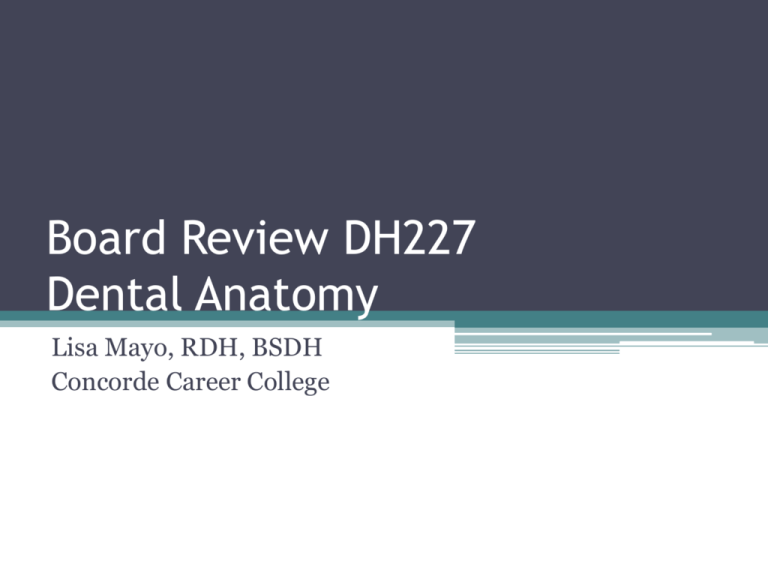
Board Review DH227 Dental Anatomy Lisa Mayo, RDH, BSDH Concorde Career College Review • Identify human dentition with terminology specific to: ▫ # of dentitions ▫ Types of teeth ▫ Terminology not related to man • Identify component of periodontium • Be able to relate eruption dates for primary and permanent teeth to clinical situations ▫ If given a picture of a dentition, identify age of pt. How Old Is This Patient? How old is this patient? How old is this patient? Review • Heterodont: man is because have many diff. types teeth • Homodont: all teeth the same • Dispyodont: man: 2 different dentitions • Monodont: 1 set of teeth • Polydont: many diff. sets of teeth Review • Know key calcification times of teeth to know later in life what caused certain conditions (fluorosis, tetracycline staining, hypocalcification, etc…) • Know how primary roots are in relation to erupting permanent teeth ▫ Succedaneous teeth: permanent teeth that replace primary (incisors, canines, premolars) ▫ Resorption ▫ Exfoliation ▫ Non-succedaneous – permanent teeth that do not replace baby tooth Primary Teeth • Also called baby, milk, temporary, deciduous, primary teeth • Exfoliation = process of losing tooth • Resorption = physiological removal of tissue or body products Primary Teeth • Bud = individual tooth buds/cap • Bell = major amount of enamel and dentin are laid down • Root development = begins when CEJ area is formed at end of the bell • Root completion = 1-2yrs after eruption • Ankylosed root = when primary tooth fuses to alveolar bone and will not exfoliate Primary Tooth Eruption ERUPTION Mand Central (8-12mo) Mand Lateral (9-13mo) Max Central (8-12mo) Max Lateral (9-13mo) 0-1 years Mand 1st Molar (13-19mo) Max 1st Molar (13-19mo) Mand Canine (16-22mo) Max Canine (16-22mo) 1-2 years Mand 2nd Molar (25-33mo) Max 2nd Molars (25-33mo) 2-6 years Eruption Sequence: central, lateral, 1st molar, canine, 2nd molar Permanent Tooth Eruption ERUPTION ROOT COMPLETION Permanent Tooth Eruption Man 1st Molar Max 1st Molar Mand Central Mand Lateral Max Central Max Lateral Mand canine Mand 1st Premolar Max 1st Premolar Mand 1st Premolar Max 2nd Premolar Max Canine 6-9 years 9-11 year 9-12 year 12-15 years Mand 2nd Molar Max 2nd Molar 12-17 years 14-16 years Mand 3rd molar Max 3rd Molar 17-21 years 18-25 years Primary Teeth vs Permanent • Enamel is thinner and whiter • Roots ▫ ▫ ▫ ▫ ▫ ▫ Same # molar-molar Mesial root wider Longer and thinner More flared No root trunks Pulp chambers large, pulp horns close to enamel • Crown ▫ Shorter ▫ Wider M-D than Occlusal-Gingival Primary Teeth vs Permanent • • • • • • Ant smaller than perm Post wider M-D More bulbous or bell shaped Cervical ridges are bulky/prominent Occlusal tables narrower Thin dentin layer between pulp and enamel Review Know general differences between perm and primary teeth, know which ones resemble each other (next slide) ▫ ▫ ▫ ▫ ▫ Enamel Color Cervical ridges Size Flare of roots Primary vs Perm PRIMARY TOOTH Max 1st Molar PERM TOOTH ROOTS IT RESEMBLES Max 1st Premolar 3 Max 2nd Molar Mand 1st Molar Mand 2nd Molar Max 1st Molar Unique crown Mand 1st Molar 3 2 2 Primary/Permanent • Mixed Dentition: 6-12 years • Most common congenitally missing permanent teeth ▫ Max laterals ▫ 3rd molars ▫ Mand 2nd premolars Review Identify key points to teeth ▫ ▫ ▫ ▫ ▫ ▫ Angle of a tooth Types of ridges # of roots # of lobes and cusps Fossas Grooves Review • Know numbering systems • Relate the size of an embrasure to contact areas of teeth • Related the size of interdental papillae to the contact area between teeth, and to the curvature of the cervical line • Know shapes of teeth from F and interprox • Know what makes certain teeth unique ▫ Ridges ▫ Concavities/Convexities ▫ Furcations Structures to Review • Boney alveolar process surrounds each tooth • Bone socket or alveolus is part of the alveolar bone in which teeth are set • Crown – anatomical vs clinical • Root - anatomical vs clinical • Enamel: 96% calcified • Dentin: 70% calcified • Cementum: 65% calcified • Cervical line /CEJ/DEJ Structures to Review • Pulp: canal, chamber, horns • Surfaces: mesial, distal, occlusal, incisal, buccal/labial, lingual • Anterior teeth, posterior teeth ▫ Know which teeth have occ vs incisal edges ▫ Know which teeth have buccal or labial ▫ Lingual sometimes referred to as palatal for max. post. • Contact area: where 2 adjacent teeth meet • Proximal surface: surfaces in-between 2 teeth • Height of the contour between 2 teeth (gets larger with age): The line encircling a tooth or other structure at its greatest bulge or diameter with respect to a selected path of insertion Structures to Review • PDL: attaches tooth to bone • Gingiva ▫ ▫ ▫ ▫ ▫ ▫ ▫ ▫ Gingival line Free gingiva Sulcus Epithelial attachment Gingival groove Attached gingiva Mucogingival junction Alveolar mucosa • Fibers Structures To Review • Line Angles: Imaginary line formed by the junction of 2 surfaces ▫ Become more rounded as go from ant to post • Point Angle: formed by the junction of 3 surfaces • Cusps: less pointed or steep as go from canine to molar Roots • Named for where they are • Root termination = apex • Root usually/typically deflect towards the distal • Concavities: 4 key areas (remember all teeth have M/D concavities!) ▫ ▫ ▫ ▫ Max 1st premolar (M) – Very prominent Max 1st Molars (L/M/D) Max Lateral(L) Mand 1st Premolar (M/D) ▫ ▫ ▫ ▫ Anterior: 1 Premolars: 1, except maxillary 1st premolars (2) Maxillary molars: 3 (2F, 1L) Mandibular molars: 2 (M&D) • Numbers Roots Lobe • Primary division of a tooth • 4 or 5 • 4- all ant and premolars except for mand molars that have 2 lingual cusps – these teeth arise from 5 lobes • Molars develop from 4 lobes except mand first that have 5 cusps and develop from 5 lobes • Developmental depressors on labial aspect separate lobes on ant teeth and buccal of premolars, not on molars (grooves) Shapes • • • • Trapezoidal: Triangular: Ovoid: Elliptical: from F and L Max anterior Canines Mand anterior • Rhomboidal: Mand posterior • Trapezoidal: Max posterior Special/Unique Structures • Max Central ▫ Lingual groove ▫ Lingual pit ▫ Mamelons • Max Lateral ▫ ▫ ▫ ▫ Linguogingival groove Lingual pit Linguogingival fissure Mamelons Special/Unique Structures • Mand Central: smallest teeth in mouth ▫ Mamelons ▫ Root concavity ▫ Longitudinal groove • Mand Lateral ▫ Mamelons ▫ Root concavity ▫ More prominent cingulum then #24,25 and deeper L fossa ▫ Cingulum: lingual cervical of ant teeth Special/Unique Structures • Canines: longest, strongest teeth, most stable tooth, provides guidance for occlusion • Max canine ▫ ▫ ▫ ▫ ▫ ▫ ▫ Canine eminence Mesioincisal/distoincisal cusp ridge/slope Labial ridge Linguogingivial groove Lingual pit Mesio/distolingual fossa Lingual ridge Special/Unique Structures Mand canine ▫ ▫ ▫ ▫ ▫ ▫ ▫ Canine eminence Slopes Labial ridge Mesio/distolingual fossa Lingual ridge Root concavity Narrower then maxillary Canine Eminence Vocabulary Ridge ▫ Marginal: found at M and D terminations of occlusal surfaces of post teeth and form the lateral borders of L surfaces ant teeth ▫ Cusp Ridge: each cusp has 4 extending from its tip (M,D,B,L) ▫ Triangular: ridge that descends from tips of cusps toward central area of occlusal surface ▫ Transverse: 2 triangular ridges merging ▫ Oblique: special type of transverse unique to MAX MOLARS from the ML to DB cusps (ML distal cusp ridge and DB triangular ridge) Vocabulary • Mamelons: small, rounded projections on incisal edges of newly erupted teeth usually worn away soon after eruption. Common on adults with malocclusion (ant open bite) • Fossa: rounded depression, pit at bottom • Developmental groove: One of the fine lines found in the enamel of a tooth that marks the junction of the lobes of the crown in its development • Secondary groove: auxiliary groove Individual Teeth: ANT • Max incisors ▫ ▫ ▫ ▫ More developed than mand Fossa and cingulum Marginal ridges Incisal edges straight except for mand lateral twisted • Max/Mand canines ▫ Max more developed ▫ Lingual ridge forms ML and DL fossa’s PREMOLARS Max Premolars General Max premolars GENERAL ▫ More similar then mand premolars ▫ 2 pointed cusps: B longer than L ▫ M marginal groove, M depression on mid-1/3 of crown down to root ▫ Single or bifrucated root (B,Palatal) and occurs apical 1/3 of root 7mm Max 1st premolar Max 1st premolars: ▫ ▫ ▫ ▫ ▫ ▫ Well-developed line angles Mesial concavity extends onto root Root bifurcated Mesial marginal groove Long central groove Lingual cusp tip offset to mesial Max 2nd premolar Max 2nd premolar ▫ More rounded line angles ▫ 1 root usually and is larger than 1st premolar ▫ Central groove shorter with more supplemental grooves ▫ M groove absent Max 2nd premolar Max 2nd premolar ▫ L cusp larger than L cusp on Max 1st premolar ▫ B cusp shorter than 1st premolar and less pointed ▫ Both cusps near same length and width ▫ Both 1 and 2 have transverse ridges Mand 1st Premolar Mand 1st premolar ▫ Sharp B cusp ▫ Short nonfunctional L cusp ▫ Central groove not always present ▫ M, D fossae with pits ▫ B cusp tip centered over root Mand 1st premolar Mand 1st premolar ▫ Transitional teeth – more resemblance to canine as far as masticatory function ▫ Transverse ridge ▫ ML developmental groove separates M marginal ridge from L cusp Mand 2nd premolar Mand 2nd premolar ▫ 2 or 3 cusps, no transverse ridges, more supplemental grooves than 1st premolar ▫ Larger than 1st premolar ▫ B cusp shorter than 1st premolar ▫ ML cusp is larger than DL ▫ Root wider than 1st premolar with a blunt apex ▫ Y-shape to central and lingual groove ▫ If 2 cusps – can have a U-shape or an H-shape to central groove MOLARS Maxillary 1st Molars Max 1st Molars ▫ 1st rhomboid occlusal pattern to cusp tip alignment ▫ Cusp of carabelli that is non-functional ▫ Largest tooth in the mouth in regards to overall bulk/ surface area ▫ Crown is wider F-L than M-D ▫ Roots trifurcated: 2B, 1 palatal (DB is the narrowest) Max 1st molar cusps Max 2nd Molars Max 2nd molars ▫ Smaller than the 1st ▫ No 5th cusp ▫ Rhomboid shape to occlusal is more accentuated ▫ Can have a heart shaped form like 3rd molar ▫ For both L root is largest then MB then DB ▫ 2 roots: MB root tip curves distally Mandibular Molars First Second Third Mand 1st molar Mand 1st Molars ▫ 1st pentagon/rectangular wider M-D than B-L ▫ Largest tooth of mand arch ▫ Bifuracted roots: roots twice as long as crown, M root longer/stronger, root apex of M turns toward D Mand 1st molar Mand 1st Molars ▫ 5 Cusps – D, 2B grooves, B and DB. (D smallest. MB cusp wider than DB ▫ No transverse ridges ▫ 4 developmental grooves: Central, B, DB, L Central groove Mand 2nd molar Mand 2nd Molars ▫ Rectangle for both distal roots are straighter, M are widest B-L than D ▫ Roots: shorter than 1st molar, closer together, M root less broad then on 1st molars 2 transverse ridges: 1st molar has NONE! Contact Areas • • • • • Become more cervical as go from ant to post Distal usually more cervical then mesial Size ↑ from ant to post Ant teeth contacts centered F-L Post teeth contacts slightly B of center Interprox Space • Triangular and filled with interdental papillae • Triangle is formed by proximal surfaces of adjacent teeth, the apex is the contact of adjacent teeth and the base is the alveolar bone • Shape changes ant to post Embrasures • Named for location: F, L, Cervical, Occlusal • For protection and stimulation of the periodontium • Form directly related to contact areas: ▫ ie. post teeth the lingual embrasures are larger than the F because the contact is to the Facial/Buccal of center Heights of Contour • For anterior: height on the labial and lingual is in the cervical third • Posterior: the B is in the cervical third • Posterior: the L is in the middle to occlusal thirds • Thirds of crowns and roots: horz and vert thirds • Cervical lines always steeper on M and D Comparing ant-post • Proximal curvature of CEJ flattens • M/D CEJ curvatures of an individual tooth: M curvature › D curvature • Lingual height of contours shift from cervical to middle 1/3 • Contact areas shift from incisal 1/3 to middle 1/3 Anomalies • Max Central 1. 2. 3. 4. Dwarfed root Hutchinson’s incisors Talon cusp Supernumerary 1. 2. 3. 4. Peg lateral Cingulum may have tubercle Congenitally missing (agenesis) Dens in dente • Max Lateral • Mand Central 1. Bifurcated root • Mand Lateral 1. Bifurcated root Anomalies • Max Canine 1. Tubercle on lingual surface • Mand Canine 1. Bifurcated root Anomalies • Max 1st Premolar 1. 3 roots 2. Antrum (root penetrating max. sinus) • Max 2nd Premolar 1. Absent central groove 2. Antrum • Mand 1st Premolar 1. ML developmental groove absent 2. Bifurcated root • Mand 2nd Premolar 1. Congenitally missing 2. Bifurcated root 3. Supernumerary Anomalies • Max 1st molar 1. Mulberry molar 2. Root variations (fusion, length) 3. Carabelli • Max 2nd molar 1. Heart-shaped occlusal 2. Tubercle on B 3. Root fusion • Max 3rd molar 1. Peg 3rd molar 2. Everything! Mulberry Molars Anomalies • Abnormal # ▫ Adontia: any missing teeth total or partial ▫ Supernumerary: mesodens most common supernumerary tooth followed by maxillary molar areas • Abnormal Size ▫ Macrodontia: true assoc. with gigantism, more commonly see large teeth ▫ Microdontia True: pituitary dwarfs False=more common, see Max laterals, peg laterals, max 3rd molars Development of two maxilla together- Genetic Malformation Anomalies • Abnormal Shape ▫ Dens in Dente: external structures become reversed in pulp chamber. “Tooth Within A Tooth” ▫ Dilaceration: linear distortion (bend) in root/crown from trauma ▫ Flexion: dilaceration root only ▫ Gemination: splitting of single tooth germ single root but looks like 2 crowns ▫ Fusion: union of 2 tooth buds only involving crowns Dens in Dente Dilaceration Anomalies ▫ Concrescence: union of 2 teeth at roots Molars most common ▫ ▫ ▫ ▫ Segmented roots Dwarfed roots Hypercementosis: excessive cementum Enamel Pearls (Ectopic enamel): on root surface furcation areas, developmental issue ▫ Hutchinson’s Teeth: prenatal syphilis, incisor may be screwdriver ▫ Mulberry: notch-shaped in incisal edge and molars Enamel Pearl Anomalies • Attrition: Mechanical wearing. Abrasive tp, oral habit, improper tb technique • Erosion: Chemical wearing. Acid or low-pH, acidic foods, drinks HELPFUL LINK http://dentistry.umkc.edu/Practicing_Communities/asset /AbnormalitiesofTeeth.pdf Anomalies • Abnormal calcification and apposition: Both may be local, systemic, hereditary factors ▫ Enamel Dysplasia / Hypoplasia Disturbance occurs during enamel matrix formation ▫ Dentiogenesis Imperfecta Affects mesodermal formation, enamel normal, tooth opalescent, gray to blue color, obliteration of pulp chambers and root canals, root shorter Genetic ▫ Amelogenesis Imperfecta Malfunction of tooth germ Enamel appears pitted, aplasia, yellow/dark brown, unusual wearing, enamel thin, hypocalcification Genetic ▫ Hypocalcification Later stage during maturation Rickets, birth trauma, idiopathic factors, congenital syphilis, fluoride What is this? Answer: Dentiogenesis Imperfecta What is this? Answer: Amelogenesis Imperfecta Amelogenesis Imperfecta Anomalies • Abnormal calcification and apposition ▫ Fluorosis: chalky white or brown, mottled teeth ▫ Focal hypomaturation: chalky white, circular, soft enamel ▫ Turner’s Teeth: injury to follicle during extraction of baby tooth or from abscess ▫ Tetracycline staining: oMinocycline: blue/gray oTetracycline: yellow/brown ▫ Taurodontism: large pulp chamber, location of the furcation is more apical, elongated crown, Down’s syndrome, “Bulls tooth” What Is This? What Is This? What is this? Answer: Taurodontism Functions • Incisors 1. 2. 3. 4. Biting Cutting Esthetics Phonetics • Canines 1. 2. 3. 4. 5. Tearing Piercing Facial Support Cosmetics Phonetics Functions • Premolars 1. Grinding 2. Esthetics 3. Phonetics • Molars 1. Grinding 2. Esthetics 3. Phonetics A&P: Mand Tooth Innervation Molars Premolars Anterior Pulp Inferior Alveolar Inferior Alveolar Inferior Alveolar B/F gingiva Buccal Buccal/Mental Mental L gingiva Lingual Lingual Lingual A&P: Max Tooth Innervations 2,3 Molars 1st Molar Premolar Canine Incisors Pulp Post Superior Alveolar Post & Middle Superior Alveolar Middle Superior Alveolar Anterior Superior Alveolar Anterior Superior Alveolar B/F Gingiva Post Superior Alveolar Post Superior Alveolar Middle Superior Alveolar Anterior Superior Alveolar Anterior Superior Alveolar Palate Gingiva Greater Palatine Greater Palatine Greater Palatine Nasopalatine Nasopalatine A&P: Muscles of Mastication • Innervation: Mandibular Division of the Trigeminal Nerve (V3) • Blood Supply: Maxillary Artery (Branch of the external carotid artery) • Medial pterygoid & masseter have similar functions & positions ▫ Medial pterygoid is internal ▫ Masseter external • Temporalis, medial pterygoid, masseter muscles all close the mouth (elevate the mandible) • Lateral pterygoid opens the mouth A&P: Muscles of Mastication Temporalis Masseter Medial Pterygoid Lateral Pterygoid Origin Temporal fossa Zygomatic arch Medial surface lateral pterygoid plate, max tuberosity Lateral surface lateral pterygoid plate, infratemporal surface sphenoid bone Insertion Coronoid process & mand post to 3rd molar Outer surface of the mand, angle of the mandible Inner surface angle of the mandible TMJ disc, neck mand condyle Function Retract, elevate mandible Elevate the mandible Elevate & protrude mandible Protrude & depress mand, lateral shift of mand A&P: TMJ Components • Temporal Bone ▫ Mandibular fossa, glenoid fossa, articular fossa ▫ Articular eminence just ant to the fossa • Mandible ▫ Condyle • Articular Disc ▫ ▫ ▫ ▫ ▫ Fibrous pad of dense collagen tissue Prevents bone to bone contact Divides joint into upper and lower synovial joints Thickest at the posterior, thinner in center Moves with condyle under normal function • Capsule ▫ Thick, fibrous tissue surrounding joint ▫ Reinforced by the temporomandibular ligament ▫ Inner lining secretes synovial fluid A&P: TMJ Movement 1. Rotation ▫ Condyle rotates in the fossa 2. Translation ▫ ▫ Condyle slides forward along the articular fossa to the articular eminence Disc moves with condyle in health 3. Trismus ▫ Hypomobility from trauma, disease, bruxism
